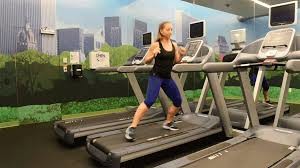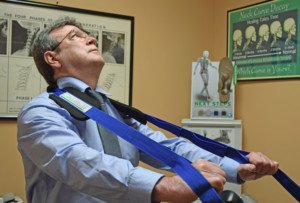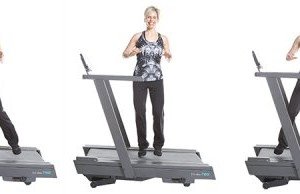
Stop doubting in your ability to walk sideways on a treadmill without holding on; this is so much simpler than you think.
I’ll have you walking hands-free next time you step onto a treadmill.
How to Walk Sideways on a Treadmill with NO Holding On
• Set the speed to 0.5 mph.
• Start walking forward.
• Place your hands on the rails to turn your body sideways.
• Get a rhythm going with your feet.
• Stand straight.
• Now let go. Your arms can move any way you please; just don’t hold onto the rails.
• Remind yourself you’re moving only 0.5 mph.
• Keep moving this way until your body feels used to it.
• At that point you can increase the speed a little.

If you’re nervous about walking sideways without holding on at even only 0.5 mph, which is the slowest a treadmill goes, then ask yourself why you’re scared.
The reason, presumably, is not based in logic. Perhaps one time you were on a treadmill and there was a power outage; the machine abruptly stopped and you fell off.
Or maybe one time you tripped over an untied shoelace.
I will assume that you are free of a medical condition that causes you to spontaneously lose balance.
In a previous article of mine, I point out that the vast majority of people I’ve ever observed over the years, who were walking sideways on a treadmill and holding onto the rails, appeared to be in their 20s and 30s.
This population typically is free of medical conditions that compromise balance.
“Unless someone requires handrail support initially to walk sideways on a treadmill because of health reasons [e.g., spinal stenosis], holding onto the rails of the treadmill will detract from its benefits,” explains Dr. Tom Carpenter, corrective exercise specialist, certified personal trainer and chiropractor, inventor of Stand Corrected™, a portable harness-like stretching tool that helps alleviate back, neck and shoulder pain.
“Hands-free side walking improves lateral (side to side) stability in regards to the kinetic chain,” continues Dr. Carpenter. “Think core. The body moves in neurologic/muscular systems naturally, not as isolated movements.
“Any interruption in this kinetic chain, such as holding onto the treadmill supports, will create adverse compensations in the way we would otherwise move naturally.”
Perhaps you’ve never been a risk taker in life, and letting go of the rails symbolizes taking some big risk that frightens you, such as quitting a job you hate.
Maybe holding onto the rails is a way to feel more control in your upheaved life.
When a young person (and older healthy person) is holding on at such slow speeds (the speed usually appears to be around one mph when someone is walking sideways), the reason has to be more psychological based than balance-problem based.
That’s just a common sense assessment on my part, especially since when I was a personal trainer some years ago, every single person I ever told to take their hands off the treadmill, had no problem whatsoever continuing to walk on the machine without holding on!
This includes older people, newcomers to the machine and obese individuals.
Remind yourself that as you walk sideways without holding onto the rail, your body is being forced into good posture; you are more upright than you’d be if your hands were on the rail.
And more:
• Your core is being 100 percent activated.
• You are not defeating the purpose—whatever that purpose is for you.
• Hands-free will train your body to be more stable in a real-life situation where movement is required in a lateral direction on an unstable surface or if you’re accidentally bumped into from the side.
• And you won’t look silly!
Over time you’ll have confidence to walk sideways on the treadmill at faster speeds—without putting your hands on the rail. I advise against even putting ONE hand on the rail. If you feel wobbly, reduce the speed.

Photo credit: Aleesia Forni

























